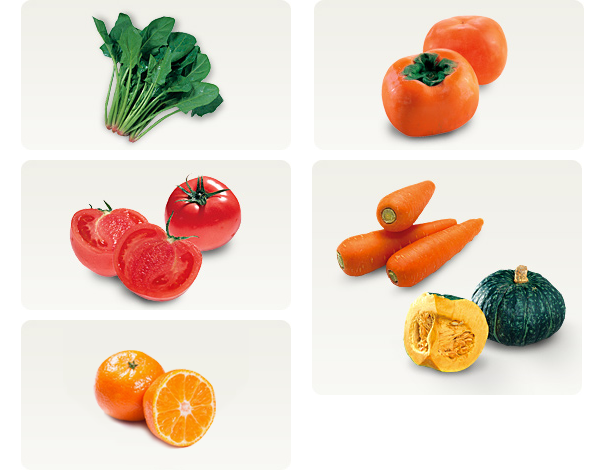
Lutein is a type of carotenoid, which is a yellow-orange pigment and is found abundantly in green and yellow vegetables. It is said to be found in the macular area of the eyes and also in the skin, breast tissue, cervix and brain. Various benefits of lutein for our body continue to be unveiled by the research on lutein explanding over the years.
Zeaxanthin is a yellow-orange pigment, with characteristics similar to those of lutein. It is abundant in corn and Fuyu persimmons, and can also be found in yellow, orange and red-coloured fruits and vegetables, egg yolk and so on. Although zeaxanthin is present in the macular area of the eye, which is similar to lutein, the highest concentration of zeaxanthin can be found in the central macular of the eye.
β-cryptoxanthin is an orange pigment abundant in unshiu mikan (satsuma mandarin oranges). Unshiu mikan is a general term for "mandarin oranges" in Japan. Besides mandarin oranges, β-cryptoxanthin is also abundant in red capsicums, papayas, persimmons, loquat and so on. Although the unshiu mikan is regularly consumed in Japan, it is not as common in other countries. Therefore, the research on β-cryptoxanthin is slower compared to the research on lycopene and other carotenoids. However, its benefits are becoming more apparent in the recent years, and now it is an ingredient that is attracting a lot of attention. It is a provitamin A that converts to vitamin A according to the needs of the body.
Both α- and β-carotene are yellow and orange pigments found in carrots and pumpkin. Known for their safety, they have been used as a colour additive in foods, drinks and cosmetics since the ancient times. Before they are converted to vitamin A, they play the role of supporting overall health as one of the phytochemicals and a carotenoid component.
It is said that lycopene is produced in tomatoes to protect them from sunlight while they ripen by absorbing sunrays. As the old European saying goes, "When tomatoes turn red, the doctor's face turns green" (A tomato a day keeps the doctor away). Today, various research findings have helped us realise that lycopene is a beneficial ingredient. Compared to absorption by eating raw vegetables, lycopene is more easily absorbed by consuming processed foods. Given its oil-soluble nature, cooking foods containing lycopene with some oil can enhance the absorption of lycopene by the body.
It is said that tomatoes need lycopene to protect themselves from the sun rays as they ripen in the sun. Since ancient times in Europe, it has been treasured as an essential nutrient for maintenance of health. Today, various research findings have helped us realise that lycopene is a beneficial component. As with all carotenoids, lycopene is also easily soluble in oil, so its absorption rate varies according to the cooking method.


The human body is made up of about 60 trillion cells, and it is the job of vitamin E to protect these cells. Super Lutein is a food with nutrient function claims (vitamin E).
"Foods with Nutrient Function Claims" refers to foods that are used to supplement or complement the daily requirement of nutrients that are lacking in the diet due to various reasons. Only when the amounts of the specific nutrient meets the prescribed national standards, it is allowed to display the function of that nutritional component.
~Food with Nutrient Function Claims: Vitamin E~
Vitamin E is an antioxidant that helps protect the cells in the body.
Anthocyanins are blue-violet pigments as well as a type of polyphenol. They were the first to gain prominence among phytochemicals. It is said that researchers became interested in anthocyanin and began the research on its properties because of an anecdote from World War II, where a British pilot reportedly attributed his excellent vision, even in the dark, to his love of blueberry jam.
DHA (docosahexaenoic acid) is an unsaturated fatty acid found abundantly in fish oil and is known for its nutritional value for growing children. Found in breast milk and in all the cells, and especially in the brain, it is essential to those who would like to work or study hard. It is said that the traditional fish-based diet of the Japanese is the main contributing factor to their longevity. There seems to be a close relationship between DHA and a healthy life.
We generate energy necessary to carry out daily activities from protein, carbohydrates, and fats – the three major nutritional substances contained in our food. The water-soluble B group vitamins are essential nutrients to maintain our overall health. As these B group vitamins leave the body when they are not absorbed, it is best to include these nutrients at every meal. Also, B group vitamins are essential nutrients as they act as coenzymes.
